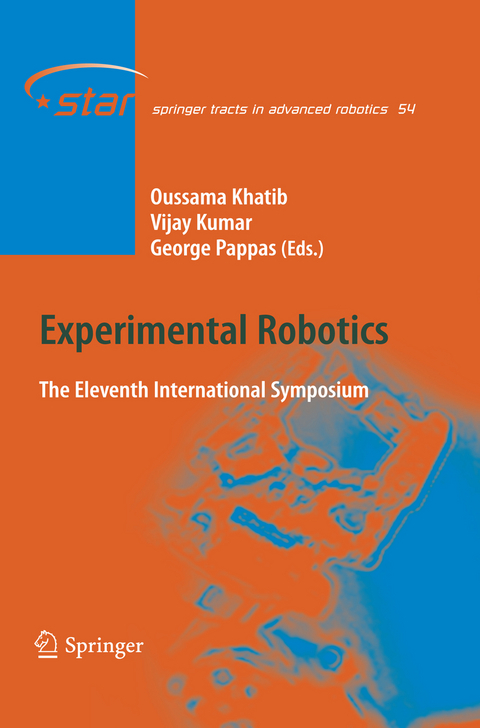
Experimental Robotics
Springer Berlin (Verlag)
978-3-642-10126-7 (ISBN)
Session 1: Design.- Session 1: Design.- The SDM Hand: A Highly Adaptive Compliant Grasper for Unstructured Environments.- Reliable External Actuation for Extending Reachable Robotic Modular Self-Reconfiguration.- Design and Development of a Soft Actuator for a Robot Inspired by the Octopus Arm.- Portable Autonomous Vehicle Controller.- Design and Control of a Bio-inspired Human-Friendly Robot.- Session 2: Autonomous Driving.- Session 2: Autonomous Driving.- Path Planning for Autonomous Driving in Unknown Environments.- Experimental Results for Over-the-Horizon Planetary Exploration Using a LIDAR Sensor.- Efficient Techniques for Dynamic Vehicle Detection.- Comparison of Boosting Based Terrain Classification Using Proprioceptive and Exteroceptive Data.- Session 3: Cooperation.- Session 3: Cooperation.- Demonstrating the Benefits of Cooperation for a UAV Team Performing Vision Based Feature Localisation.- Maintaining Connectivity in Mobile Robot Networks.- From Theory to Practice: Distributed Coverage Control Experiments with Groups of Robots.- Co-ordinated Tracking and Planning Using Air and Ground Vehicles.- Distributed Robotic Radiation Mapping.- Session 4: Mini and Micro Robots.- Session 4: Mini and Micro Robots.- Visual Tracking for Teams of Miniature Robots.- Small, Fast, and under Control: Wireless Resonant Magnetic Micro-agents.- Visually Servoed Orientation Control of Biological Cells in Microrobotic Cell Manipulation.- Session 5: Human Robot Interaction.- Session 5: Human Robot Interaction.- A First Investigation into the Teleoperation of a Miniature Rotorcraft.- Toward Socially Assistive Robotics for Augmenting Interventions for Children with Autism Spectrum Disorders.- Teaching Robots via Natural Nonverbal Cues.- The Psychological Effects of Attendance of an Android on Communication.- SHARY: A Supervision System Adapted to Human-Robot Interaction.- Session 6: Medical Robotics.- Session 6: Medical Robotics.- EMG-Based Position and Force Estimates in Coupled Human-Robot Systems: Towards EMG-Controlled Exoskeletons.- An Image-Based Localization Algorithm for Catheter Navigation in the Left Atrium.- Mechanical Response of Embryonic Stem Cells Using Haptics-Enabled Atomic Force Microscopy.- Task-Space Control of Continuum Manipulators with Coupled Tendon Drive.- Session 7: Locomotion.- Session 7: Locomotion.- Passing under Obstacles with Humanoid Robots.- Planning Support Contact-Points for Acyclic Motions and Experiments on HRP-2.- A Physical Model for Dynamical Arthropod Running on Level Ground.- Reliable Dynamic Motions for a Stiff Quadruped.- Bioinspired Jumping Locomotion in Small Robots: Natural Observation, Design, Experiments.- Session 8: Localization and Mapping.- Session 8: Localization and Mapping.- A Robust Method of Localization and Mapping Using Only Range.- Visual Appearance Mapping for Optimal Vision Based Servoing.- Place Recognition Using Keypoint Similarities in 2D Lidar Maps.- A First-Estimates Jacobian EKF for Improving SLAM Consistency.- Session 9: UUVs and UAVs.- Session 9: UUVs and UAVs.- Autonomous Autorotation of an RC Helicopter.- Preliminary Results for Model-Based Adaptive Control of an Autonomous Underwater Vehicle.- Simultaneous Localisation and Mapping and Dense Stereoscopic Seafloor Reconstruction Using an AUV.- A Boosting Approach to Visual Servo-Control of an Underwater Robot.- Saving Energy with Buoyancy and Balance Control for Underwater Robots with Dynamic Payloads.- Session 10: Sensing and Planning.- Session 10: Sensing and Planning.- Adaptive Full Scan Model for Range Finders in Dynamic Environments.- Empirical Sampling of Path Sets for Local Area Motion Planning.- Motion Strategies for People Tracking in Cluttered and Dynamic Environments.- Tracking Odor Plumes in a Laminar Wind Field with Bio-inspired Algorithms.- Session 11: Vision.- Session 11: Vision.- Closed-Form Differential Kinematics for Concentric-Tube Continuum Robots with Application to Visual Servoing.- Humanoid Vision Resembles Primate Archetype.- Learning to Associate Image Features with CRF-Matching.- Fast Relative Pose Calibration for Visual and Inertial Sensors.- Scale Invariant Detection and Tracking of Elongated Structures.- Session 12: Manipulation.- Session 12: Manipulation.- Shape Recognition and Optimal Grasping of Unknown Objects by Soft-Fingered Robotic Hands with Camera.- Coordinated Control and Range Imaging for Mobile Manipulation.- Experimental Evaluation of Several Strategies for Human Motion Based Transparency Control.- Development of a Manipulation Component for a Container Transferring Robot in Living Space.
| Erscheint lt. Verlag | 22.10.2010 |
|---|---|
| Reihe/Serie | Springer Tracts in Advanced Robotics |
| Zusatzinfo | XVII, 582 p. |
| Verlagsort | Berlin |
| Sprache | englisch |
| Maße | 155 x 235 mm |
| Gewicht | 889 g |
| Themenwelt | Informatik ► Theorie / Studium ► Künstliche Intelligenz / Robotik |
| Technik ► Elektrotechnik / Energietechnik | |
| Technik ► Maschinenbau | |
| Schlagworte | Actuator • algorithms • Android • autonom • CAM • Communication • exoskeleton • Flying Robots • Haptics • human centered robotics • humanoids • Human-Robot Interaction • Kinematics • Medical Robotics • Mobile Robot • Motion Planning • Multiple Robots • Navigation • Path Planning • Robotics research • Robot Navigation • Robot Perception • sensing • SLAM • SLAM (Simultaneous Localization and Map Building) • ugmented Reality • unmanned aerial vehicle • Vision • Walking Robots |
| ISBN-10 | 3-642-10126-7 / 3642101267 |
| ISBN-13 | 978-3-642-10126-7 / 9783642101267 |
| Zustand | Neuware |
| Haben Sie eine Frage zum Produkt? |
aus dem Bereich


